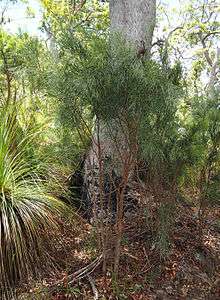Jacksonia scoparia
| Jacksonia scoparia | |
|---|---|
 | |
| Flowering Jacksonia scoparia | |
| Scientific classification | |
| Kingdom: | Plantae |
| (unranked): | Angiosperms |
| (unranked): | Eudicots |
| (unranked): | Rosids |
| Order: | Fabales |
| Family: | Fabaceae |
| Subfamily: | Faboideae |
| Genus: | Jacksonia |
| Species: | J. scoparia |
| Binomial name | |
| Jacksonia scoparia Sm. | |
Jacksonia scoparia, commonly known as dogwood (from its strong odour when burning), is a native species of a pea-flowered, greyish, leafless, broom-like shrub or small tree that occurs in the south east of Queensland, Australia and eastern New South Wales. It is often seen growing on high exposed ridges in and around the Oxley Wild Rivers National Park on the Northern Tablelands (New South Wales). The yellow 'pea'-type flowers appear in October and November in racemes from the upper branches.[1]
During droughts, dogwood has provided a useful fodder that is relished by cattle. Propagation is relatively easy from seed following pre-treatment with boiling water (similar to other members of the pea family). Cuttings also strike reasonably readily.[2]
Named in its honour
Dogwood Creek in Queensland was named after the profusion of Jacksonia scoparia in the area by explorer Ludwig Leichhardt on 23 October 1844 during his expedition from Moreton Bay to Port Essington (now Darwin, Northern Territory).[3]
References
- ↑ Bodkin, Frances (Compiler), Encyclopaedia Botanica - the Essential Reference Guide to Native and Exotic Plants in Australia, Angus and Robertson, North Ryde, 1990, ISBN 0-207-15064-8
- ↑ Wrigley, John W.; Fagg, Murray, Australian Native Plants : Cultivation, Use in Landscaping and Propagation, Reed Books, Kew, Victoria, 1997, ISBN 0-7301-0493-1
- ↑ "Dogwood Creek (entry 10268)". Queensland Place Names. Queensland Government. Retrieved 27 March 2014.